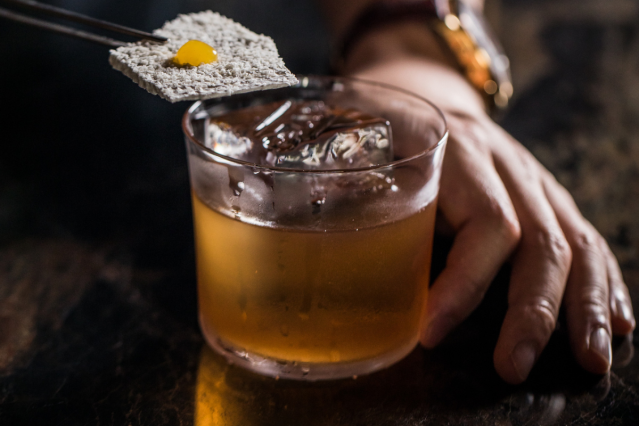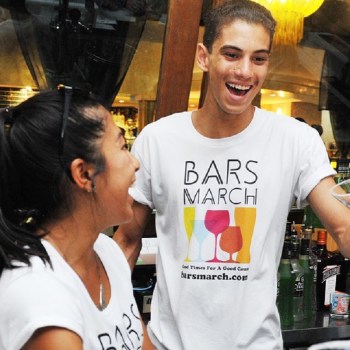Across the country, an ancient English drink of mysterious origins is sharing the menu with modern classics like the Aperol Spritz and the Espresso Martini: the clarified milk punch.
It’s a somewhat convoluted cocktail to produce, and the immediate prospect of dairy products in their cocktails can be off-putting for some consumers – who conjure images of a cloudy, heavy and creamy affair. So why are bartenders turning to this drink in droves?
For Steve McDermott, former Group Bar Manager of Hunter St Hospitality (which operates the newly opened Rocks bar, Alice), it’s all about piquing the interest of the drinker.
“When you’re designing a menu, and particularly a new menu for high-cocktails, you want things that are going to capture a guest’s attention.”
This is perhaps the greatest draw of the clarified milk punch. On Alice’s menu, the ‘Lunchbox Milk Punch’ is described as containing pisco, Nippy’s iced banana milk and lime juice. Drinkers could well be forgiven for thinking they were about to receive an opaque and dense, dessert-like drink. Instead, when the cocktail arrives, it is nearly perfectly clear.
“The reason we call it the lunchbox is we use Nippy’s iced banana, they come in little juice box things that kids get in their lunchbox,” Steve says.

It’s a classic bait and switch, and at their best, clarified milk punches lend a sense of theatre to a menu and to a guest’s experience, playing with their expectations, before delivering something entirely different.
“Any time there’s a technique that can wow your guests a little bit – bartenders are into it. Bartenders also like to show off a little bit, if you have something that’s a bit difficult that not everyone can do, that’s another box ticked,” Steve adds.
And of course, there is the simple matter of flavour, as Steve says: “It’s delicious as well. It adds a little bit of extra texture from the milk which is absolutely beautiful.”
The beginnings of the drink are altogether more practical. According to esteemed cocktail historian, David Wondrich, the first recipe for a milk punch of this style was written in 1711, when housewife Mary Rockett combined hot milk, brandy, lemon and spices. The libation is mentioned even earlier, in the 1688 writings of English politician, William Sacheverell.
Darren Leaney, Head of Product for Home Grown Drinks (a bottled cocktail company and hospitality co-working space) and previously bar manager at Carlton’s Capitano sheds some light on this history.
“Clarified milk punches are a purely English invention, where it was a preservative, predating refrigeration. So they’d take fresh milk, cider, or wine – whatever they had on hand, then using that way – that’s stable for a lot longer than fresh raw milk would be.
“The addition of all these other alcohols makes it more interesting, more delicious and also has that greater shelf life,” Darren continued.
Milk punch perhaps has forerunners in Possets and Syllabubs, two other English cocktails of the era, which involve curdling milk with alcohol, then eating the curds and drinking the whey – a much less attractive proposition for the modern drinker.
Since this genesis, the drink has attracted everyone from Benjamin Franklin, to Eleven Madison Park’s Eamon Rockey – and plenty of Australian bartenders too.
With milk punches, an acidic base of alcohol and citrus juice is usually made before hot milk is added and deliberately curdled. The curds are then strained away, producing a perfectly clear final product, with a creamy mouthfeel and intense flavour.
From this simple formula, clarified milk punches have become increasingly more complex, as illustrated by the rendition found on Capitano Menu: a tiramisu milk punch.
“We had a tiramisu on the food menu, so it made so much sense to do a tiramisu cocktail to align with it – and I guess, to show off. Capitano was always a modern Italian-ish restaurant, so it made sense to have a very classical flavour here with tiramisu, a very, very classical preparation, but a very modern presentation,” Darren explains.

The cocktail is made by infusing cacao with rum, and milk with the traditional Savoiardi biscuits used in a tiramisu.
Leaney also believes that bartenders have been attracted to the flexibility offered by the drink.
“Obviously they work really well as a fresh drink, you can top the drink with soda, you can make a sour that your pour out of the bottle. But for me, the best application is to do dessert style cocktails, because you taken drinks that would be creamy, they could be buttery or they could be pastry-led, and you can present them as a clean clarified drink that looks like a really rich whisky,” Leaney says.
This is a facet of this style of drink also raised by Marco Rosati, Bar Supervisor at Grain Bar.
“It’s so versatile,” Marco says.
“You can make a sweeter version – it doesn’t have to be citrus inside, it can also be spirit forward.”
At Grain, Marco serves up a ‘Maraca Milk Punch’, which includes coconut water, pineapple and rum, and is garnished with a meringue dusted with toasted coconut – a sweeter style of drink that recalls a traditional rum punch.

“At Grain, every cocktail has a grain in it. This one is mainly oat. We do a toasted oat with star anise, cassia bark and a few other spices, to that we add our coconut water. Then once its warmed up we add our Montenegro and Diplomatico dark rum, then we add pineapple juice,” Marco outlines.
“Once the batch is ready, we dump all the mixture inside milk – not the opposite, because to have the reaction you need all the liquids to be in touch with the protein of the milk.
“Then it starts to curdle up and separate. Once it’s done, we can actually keep it for three weeks, but we never keep it for more than a week because we always run out!”
Marco has also reimagined this kind of punch for his entry into the Diageo World Class competition, which saw him rank in the top 100 bartenders worldwide.
Here, a clarified base was reimagined into a highball style drink, with driven by an almost-umami like flavour profile.
“You can use different techniques, you can make a savoury version like my drink, make it your base for highballs.”
“It’s all the preparation behind it that will make a good drink.”
And although milk punches require a little bit more leg work in preparation, the actual service is much faster than other kinds of cocktails. Milk punches can be pre-batched, they require no additional dilution, and can be served directly from the fridge.
“When you drink a milk punch, it’s already been diluted from the preparation,” Marco says.
“You can have a consistency, and that’s what we tend to have in Grain – a consistency with every drink. So on the preparation side, we all have the same specs. So whether you get a drink from me, Adam [Lau, Grain Bar Manager] or Tanmay [Shrivastava, Bartender] it’s going to be the same.”
Like Steve, Marco also highlights the ‘wow factor’ as a reason for milk punch’s return to popularity.
“When people taste it, they’re like actually, ‘wow’, and when you explain to them that it’s got a rum base, pineapple, lemon, sugar, spices, but actually if you look at it, it looks like water. So they’re surprised – it’s a very complex drink.”
And for Marco, this is a trend that shows no sign of slowing.
“All the bars have a milk punch, when I went to Dean and Nancy they had one… everywhere I go they have one milk punch. So I think, the more we go forward, the more we bring back the basics of the past.”
“Milk punches are the future of more drinks coming up – an easy to clarify drink, and super tasty,” Marco concludes.
Want the recipes for the drinks mentioned in this feature? Click here.



